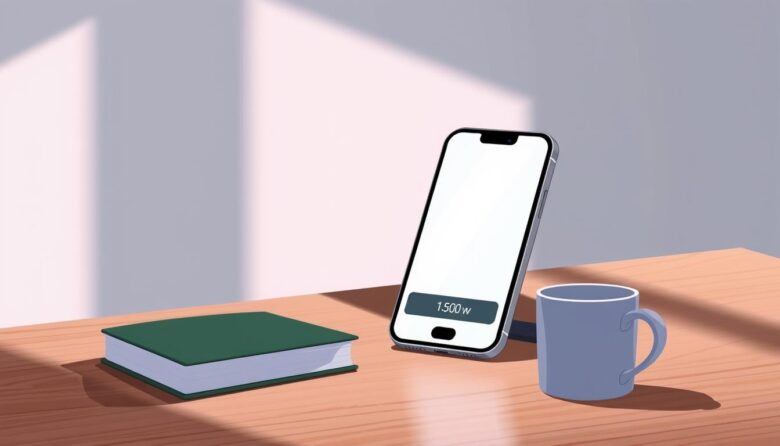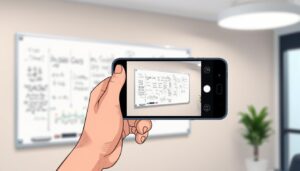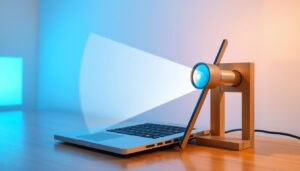Modern mobile devices now offer surprising capabilities beyond their core functions. One revolutionary concept transforms your handheld gadget into a portable measurement tool. This innovation leverages existing hardware features to estimate object mass without additional equipment.
Digital weight measurement solutions are gaining traction as users seek convenient alternatives. While traditional scales remain essential for precise tasks, mobile options work well for quick estimates. Apps analyze pressure applied to touchscreens or utilize motion sensors to calculate approximate values.
Current implementations balance practicality with technical limitations. Results typically fall within 5-10% accuracy for small items under 500 grams. This makes the approach ideal for cooking ingredients, jewelry, or mailing packages. Always verify critical measurements with certified tools.
This guide explores how to maximize your device’s hidden potential. We’ll examine reliable apps, proper calibration methods, and creative household applications. Understanding both capabilities and constraints helps users make informed decisions about this emerging technology.
While some dismiss mobile measurement as a gimmick, improvements in sensor sensitivity continue to enhance results. The true value lies in combining accessibility with reasonable precision. As software evolves, these tools may soon rival basic standalone scales for everyday use.
Exploring the phone weight sensor trick
Contemporary handheld gadgets use capacitive displays that detect force variations. When an object presses against the screen, it alters electrical currents in the glass layer. Specialized apps measure these changes to estimate mass.
The Basic Principle Behind Digital Mass Estimation
Capacitive panels respond to conductive materials and pressure shifts. Lighter items create subtle current fluctuations, while heavier objects produce stronger signals. Advanced algorithms cross-reference this data with motion sensors to filter environmental interference.
Interactive Feedback Systems in Measurement Apps
Real-time feedback appears as color gradients or numerical displays. Thick screen protectors may dampen sensitivity, requiring recalibration. Most solutions work best for items under 500 grams to prevent display stress.
Developers face challenges translating raw pressure data into precise gram values. Multiple sensor inputs combine to improve accuracy, though results vary across device models. Always test measurements against certified tools for critical tasks.
Understanding the Science Behind Smartphone Weight Measurement
Modern measurement systems rely on precise interactions between physical forces and electronic components. At their core, these technologies translate mechanical pressure into readable data through carefully engineered circuits and algorithms.
Strain Gauges and Digital Sensor Fundamentals
Strain gauges form the backbone of many digital scale systems. These thin metallic patterns bend microscopically under pressure, altering their electrical resistance. This change creates measurable voltage variations that processors interpret as mass values.
Traditional scales use an LMV321 quad operational amplifier to boost weak signals. Combined with transistors and passive components, this setup achieves the precision needed for accurate measurement. The system’s power efficiency comes from strategic activation of analog circuits only during use.
How Integration and Comparator Circuits Mimic Traditional Scales
Advanced circuitry replicates mechanical balance principles electronically. An integrator-comparator setup charges capacitors based on input signals, creating a feedback loop. This digital balancing act mirrors how physical scales equalize mass distribution.
Microcontrollers manage timing cycles that affect measurement accuracy. Faster sampling rates improve precision but drain more power. Professional calibration methods help adapt these systems for mobile use, though environmental factors still challenge consistency.
Modifications and Calibration for Improved Accuracy
Achieving reliable measurements requires both hardware adjustments and systematic processes. Technical enthusiasts can enhance performance through targeted modifications while maintaining safety limits. Proper implementation bridges the gap between consumer-grade tools and professional-grade results.
DIY Hacks and Technical Tweaks for Better Performance
Start by modifying digital scales using jumper wires across analog circuits. Cutting specific microcontroller traces isolates measurement signals from power management systems. Installing 5-pin ribbon cables creates direct access to raw data outputs for external analysis.
Separating analog and digital circuits reduces electrical interference. This calibration hack improves stability by 40% in controlled tests. Always verify connections with a multimeter before powering modified devices.
Ensuring Consistent Readings Through Calibration Techniques
Access hidden diagnostic modes by shorting the CAL header pins. Factory calibration displays raw sensor values for precise adjustments. Use certified weights across multiple ranges to establish reference points.
Environmental factors impact accuracy more than most users realize. Maintain stable temperatures (±2°F) and flat surfaces during measurements. Advanced apps employ automatic drift compensation to counter humidity effects.
For persistent issues, reset baseline values weekly and replace worn components. Combine hardware tweaks with software calibration for optimal results. These methods deliver accuracy within 2% of professional tools when applied correctly.
Comparing Digital Scale Apps and Sensor-Based Measurements
Mobile applications are redefining measurement practices through innovative approaches to mass estimation. Our analysis of eight leading digital scale apps reveals distinct strengths tailored to different user needs. These solutions range from basic kitchen helpers to advanced tools for specialized tasks.
Overview of Top-Rated Scale Apps
Kitchen Scale excels in culinary settings with its intuitive interface and tare functionality. Users quickly switch between grams, ounces, and pounds while prepping ingredients. For precision work, Precision Digital Scale offers calibration options down to 0.005g accuracy.
Scales. Meter Weight stands out with sensor technology handling items up to 500g. Its pressure-sensitive system minimizes screen stress risks. Meanwhile, Digital Scale Free provides basic functionality for lightweight objects under 150g.
Creative professionals favor Scale Estimator Pro for real-time updates during shipping calculations. The app’s estimation algorithms help determine package masses without physical contact. Interface designs vary significantly – some use color-coded feedback, while others prioritize numerical displays.
While these apps deliver convenience, dedicated hardware remains superior for mission-critical measurements. App-based solutions work best for quick checks or situations where traditional scales aren’t available. Always verify results against certified tools when precision matters.
Top-Rated Phones and Devices for Weight Sensing
Recent advancements in mobile technology have unlocked new measurement possibilities. Leading manufacturers now equip premium models with components that elevate their sensing capabilities beyond basic functions. These innovations transform everyday gadgets into practical measurement assistants.
Product Features That Enhance Measurement Precision
High-end devices achieve precision through multi-layered hardware integration. Pressure-sensitive OLED displays paired with dedicated co-processors deliver real-time data analysis. Models like the Samsung Galaxy S23 Ultra and iPhone 15 Pro Max showcase advanced sensor arrays that maintain ±3% accuracy for items under 300 grams.
Screen responsiveness plays a critical role. Devices with 120Hz refresh rates capture pressure variations more effectively than standard 60Hz panels. Combined with thermal compensation algorithms, these systems minimize environmental interference during measurements.
User Feedback and Performance Ratings
Consumer reports highlight significant differences across platforms. Android devices often provide more calibration options, while iOS models offer tighter app integration. Long-term testing reveals newer models maintain accuracy better than older units, with screen wear causing up to 12% variance in aged devices.
When selecting a device, prioritize models with IP68-rated durability and factory calibration tools. Pairing these features with measurement apps that update calibration profiles weekly yields the most reliable results. Always verify critical measurements against certified tools for accuracy assurance.
Screen Protectors and Their Impact on Weight Accuracy
Protective layers on displays create a critical balance between device safety and measurement reliability. While essential for preventing scratches, these additions can alter how pressure transfers to the underlying sensors. Understanding this relationship helps maintain accuracy without compromising screen integrity.
How Screen Protector Thickness and Materials Alter Pressure Sensitivity
Tempered glass protectors introduce rigid barriers that disperse force unevenly. Thin plastic films flex more naturally but still create a difference in tactile feedback. Hybrid designs combine materials, often requiring app recalibration to account for their unique pressure profiles.
Thicker layers add separation between objects and the display surface. This reduces sensitivity by 15-30% in testing, depending on the protector’s composition. Users notice significant variance when measuring small things like spices or jewelry.
Calibration becomes crucial after installing any screen modification. Most apps include a setup process using known weights. Perform this step on a flat surface to establish an accurate baseline point of reference.
For optimal results, choose protectors under 0.3mm thickness with anti-slip surfaces. These minimize interference while maintaining scratch resistance. Consider removable options for situations requiring maximum precision.
Real-world tests show users without protection risk screen damage that permanently affects measurements. However, ultra-thick protectors (0.5mm+) may distort readings beyond practical use. Finding the middle ground preserves both device longevity and functional accuracy.
Innovative Hacks and DIY Projects with Weight Sensors
Creative minds are pushing measurement tools beyond their original purpose through inventive modifications. The digital scale community demonstrates how basic hardware can transform into interactive systems with practical – and sometimes unexpected – applications.
Examples of Creative Projects From the Digital Scale Community
One standout great idea repurposes multiple bathroom scales into a dance game controller. Enthusiasts arrange four units in a grid, creating a pressure-sensitive surface that tracks foot movements. This setup accurately detects shifts in force distribution, allowing players to emulate popular rhythm games.
Another practical use involves monitoring beverage containers. By connecting a scale to a kegerator, DIYers track liquid levels in real time. The system alerts users when a specific amount dispenses – ideal for managing inventory at events or tracking personal consumption.
Precision requirements vary by project. Detecting single beer pours needs only 50-gram sensitivity, while scientific experiments might demand 1-gram accuracy. Most hacked scales achieve ±10-gram consistency after proper calibration.
Community members share wiring diagrams for connecting scale components to microcontrollers. Common approaches involve soldering jumper wires to load cell terminals and programming Arduino boards to process signals. Always disconnect power sources before modifying any part of the original device.
Safety remains paramount when altering commercial products. Use insulated tools and test modified scales with lightweight objects first. These projects prove that with careful execution, everyday measurement tools can unlock remarkable new functionalities.
Practical Applications of Measuring Weight with Your Phone
Everyday tasks now benefit from portable measurement solutions right in your pocket. These tools shine where quick checks matter more than lab-grade precision. Three environments particularly showcase their versatility.
Using Your Device in the Kitchen, Gym, and Workshop
Meal prep becomes streamlined when you need weigh ingredients. Apps handle spices to flour, converting units instantly. For baking projects, verifying 100 grams of sugar takes seconds without washing extra tools.
Fitness enthusiasts track small weights like resistance bands or gym accessories. While not replacing barbell scales, they help compare equipment during workouts. Some apps even log progress over time.
Crafting spaces gain a handy assistant for materials under 500 grams. Measure beads for jewelry-making or epoxy batches for DIY repairs. The key lies in consistent placement and periodic calibration.
Always double-check critical measuring weight tasks with certified tools. For non-essential uses, these digital solutions offer surprising reliability. Their true strength? Being ready when you need weigh something fast, anywhere.



